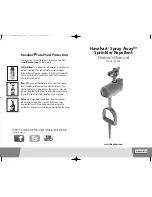
Chapter 5
Calibration Procedures
© National Instruments Corporation
5-3
AT-MIO-16D User Manual
Analog Input Calibration
To null out error sources that compromise the quality of measurements, you must calibrate the
analog input circuitry by adjusting the following potential sources of error:
•
Offset error at the input of the instrumentation amplifier
•
Offset error at the input of the ADC
•
Gain error of analog input circuitry
Offsets at the input to the instrumentation amplifier contribute gain-dependent error to the analog
input system. This offset is multiplied by the gain of the instrumentation amplifier. To calibrate
this offset, you must ground the analog input, read it at two different gain settings, and adjust a
trimpot until the readings match at the two different gain settings.
Offset error at the input of the ADC is the total of the voltage offsets contributed by the circuitry
from the output of the instrumentation amplifier to the ADC input (including the offsets of the
ADC). Offset errors appear as a voltage added to the input voltage being measured. To calibrate
this offset, you must apply V-
fs
+
1
/
2
LSB to the analog input circuitry and adjust a trimpot until
the ADC returns readings that flicker between its most negative count and the most negative
count plus one. The voltages corresponding to V-
fs
and 1 LSB are given in the following table.
All the stages up to and including the input of the ADC contribute to the gain error of the analog
input circuitry. With the instrumentation amplifier set to a gain of 1, the gain of analog input
circuitry is ideally one. The gain error is the deviation of the gain from 1 and appears as a
multiplication of the input voltage being measured. To calibrate this offset, you must apply
V+
fs
-
3
/
2
LSB to the analog input circuitry and adjust a potentiometer until the ADC returns
readings that flicker between its most positive count and the most positive count minus one.
The voltages corresponding to V+
fs
and 1 LSB are given below.
The voltages corresponding to V-
fs
, which is the most negative voltage that the ADC can read,
V+
fs
- 1, which is the most positive voltage the ADC can read, and 1 LSB, which is the voltage
corresponding to one count of the ADC, depend on the input range selected. The value of these
voltages for each input range is given in this table:
Input Range
V
-fs
V
+fs
- 1
1 LSB
1
/
2
LSB
-10 to +10 V
-10 V
+9.99512 V
4.88 mV
2.44 mV
-5 to +5 V
-5 V
+4.99756 V
2.44 mV
1.22 mV
0 to 10 V
0 V
+9.99756 V
2.44 mV
1.22 mV
Summary of Contents for AT-MIO-16D
Page 16: ......
Page 23: ......
Page 185: ......
Page 206: ......
Page 207: ......
Page 208: ......
Page 209: ......
Page 210: ......
Page 211: ......
Page 212: ......
Page 213: ......
Page 214: ......
Page 215: ......
Page 216: ......
Page 217: ......
Page 218: ......
Page 219: ......
Page 220: ......
Page 221: ......
Page 222: ......
Page 223: ......
Page 224: ......
Page 225: ......
Page 226: ......
Page 227: ......
Page 228: ......
Page 229: ......
Page 230: ......
Page 231: ......
Page 232: ......
Page 233: ......
Page 234: ......
Page 235: ......
Page 236: ......
Page 237: ......
Page 238: ......
Page 239: ......
Page 240: ......
Page 241: ......
Page 242: ......
Page 243: ......
Page 244: ......
Page 246: ......
Page 247: ......
Page 248: ......
Page 249: ......
Page 250: ......
Page 251: ......
Page 252: ......
Page 253: ......
Page 254: ......
Page 255: ......
Page 256: ......
Page 257: ......
Page 258: ......
Page 259: ......
Page 260: ......
Page 261: ......
















































